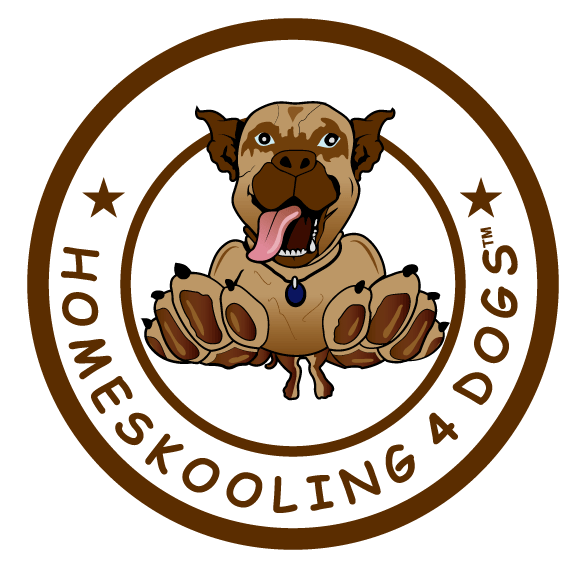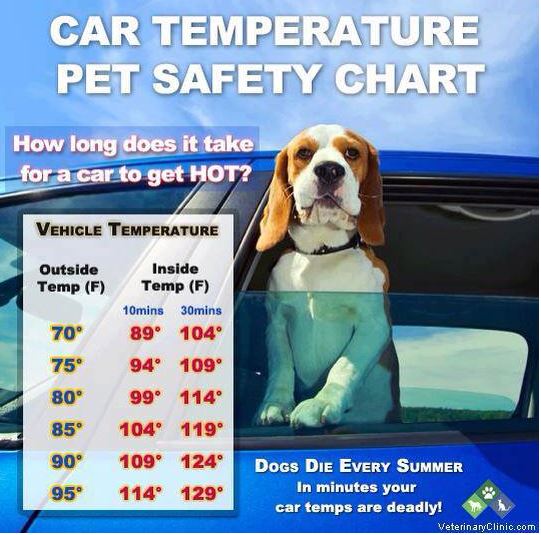overheating & Heat Stroke
Best Way To Cool A Dog
Dehydration & Overheating
Signs of Shock & Heatstroke
Vehicle Deaths & Overheating
How to Treat Heat Exhaustion in Dogs and Cats
How to Treat Heat Stroke in Dogs and Cats
Ways To Help Keep A dog Cool
What’s The Best Way to Cool a Dog?
“A recent study compared three mechanisms for cooling dogs after 15 min treadmill exercise in a room at 30 degrees C (86 degrees F) (5). Dogs that were dipped in water for 5 minutes at ambient temperature had cooled in 16 minutes. Dogs that were placed in a kennel on a cooling mat at 4 degrees C (39 degrees F) with a fan took 36 minutes to cool. And dogs that were just in a kennel with a fan took 48 minutes to cool down. The authors suggested that water immersion is a method for not only treating but also for preventing overheating when dogs exercise.” [1]
Exercise/Walking Temperatures
Every dog will have a different heat tolerance. A good general rule is no running unless under 60F. Above 60F walking, you should monitor your dog for heat tolerance. Above 60F in full sun you may need to keep walks short. For my dog Gromit, above 64F we need to walk in shaded areas. Above 80F we only get out for minutes when necessary for short breaks.
Please don’t push your dogs to do more. Remember they can not cool their bodies as efficiently or as quickly as humans.
Dehydration / Overheating (Get Medical Help)
Heavy panting
Tongue and mucous membranes bright red
Saliva is thick and tenacious
Vomits
Dry mount
Sticky gums
Signs of shock (emergency)
Lips and gums pale or gray
Collapse
Seizures
“Exercise-Induced Collapse (EIC) is a genetic neuromuscular disorder characterized by muscle weakness, lack of coordination and life-threatening collapse after intense exercise in otherwise apparent healthy dogs.” [2] EIC and BCC (Border Collie Collapse) is mistaken for heat stroke which is a very different condition. [2] For information on EIC tap or click here. “Severely affected dogs may collapse whenever they are exercised to this extent - other dogs only exhibit collapse sporadically. The first thing noted is usually a rocking or forced gait. The rear limbs then become weak and unable to support weight. Many affected dogs will continue to run while dragging their back legs. Some of the dogs appear to be incoordinated, especially in the rear limbs, with a wide-based, long, loose stride rather than the short, stiff strides typically associated with muscle weakness. In some dogs the rear limb collapse progresses to forelimb weakness and occasionally to a total inability to move.” [3]
By Dr. Becker
Vehicle Deaths & Overheating
https://vawx.net/protect-the-paws?fbclid=IwAR3D8kcVL05CUNJ2s5DoO1OctQkDQkabvCPHf6f0BMS1tVgnumHNr1SZd2o
Crucially Important Aspects of Cooling in Cases of Heat Exhaustion and Heat Stroke in Cats and Dogs
Do NOT pour water into the mouth of a collapsed or unconscious pet, and don’t force any pet to drink water either.
Do NOT use ice water or an ice bath to cool an overheated pet. Doing so will lead to constriction of the blood vessels under the pet’s skin which will actually prevent the pet from cooling off.
Do NOT cool your pet too fast or too far – overcooling can be as disastrous as overheating.
Do monitor rectal temperature every 30-60 seconds.
Do stop cooling once rectal temperature reaches 103.5°F.
All pets suffering from heat stroke (and many suffering from heat exhaustion) still need to be evaluated by a veterinarian once your initial cooling measures have been completed.
How to Treat Heat Exhaustion in Dogs and Cats
Move your pet into a safe, shady or air-conditioned environment to prevent injuries and further heat absorption.
Offer small amounts of water frequently.
Measure rectal temperature with a thermometer (preferably digital, rather than glass) and plenty of lube (you can also use water or saliva, if no lube is readily available). If your pet’s temperature is below 104°F, continue on to step #4 in this list. If his temperature is above 104°F, proceed to step #5 in the list below (treating heat stroke).
Continue to monitor your pet and allow him to rest and drink small, frequent amounts of water.
Once he is back to his normal self, return home with him, but continue to keep a close eye on him for the next 24 hours. Bring him for veterinary evaluation immediately if he doesn’t return back to his normal self or if there are any episodes of vomiting, diarrhea, lack of appetite or any other concerning signs.
How to Treat Heat Stroke in Dogs and Cats
Move your pet into a safe, shady or an air-conditioned environment to prevent injuries and further heat absorption. Put a cool, wet towel or blanket underneath him.
If he is alert enough and able to drink water, offer him small amounts frequently. You don’t want him drinking too much or too fast, as either of those can cause problems of their own.
Check and take note of the time. This will be helpful when you arrive at the vet, and it will also keep you from performing first aid too long and unnecessarily delaying veterinary treatment.
Measure rectal temperature with a thermometer (preferably digital, rather than glass) and plenty of lube (you can also use water or saliva, if no lube is readily available).
If his temperature is above 104°F, begin cooling by spraying cool (not cold) water over their body. If you have a fan handy, you can turn it on and have it blow over him – this will improve evaporative cooling.
Stop cooling once his temperature reaches 103.5°F.
Check and take note of the time that cooling was stopped and at what temperature he was at when cooling was stopped.
If there is a dry towel or blanket available, use it to dry your pet off slightly. This can help prevent continued and excessive cooling.
Bring your pet immediately for veterinary evaluation and care. Ideally pre-cooling your car before getting you pet in and calling ahead to the veterinary hospital to let them know you’re on your way with a pet that has suffered heat stroke.
Ways To Help Keep A dog Cool
Exercise during the cooler part of the day.
Don’t leave in a vehicle.
Don’t over-exercise.
Chilly Buddy Cooling Vest https://chillybuddy.com/








